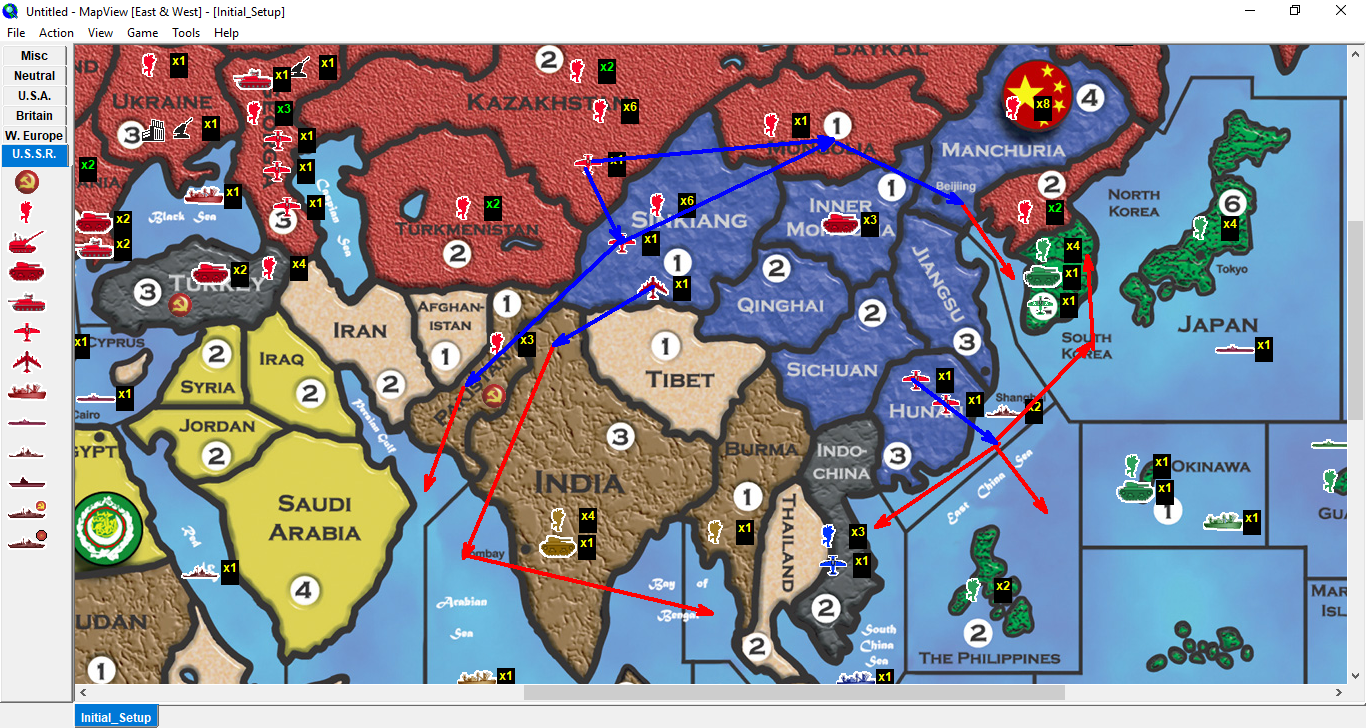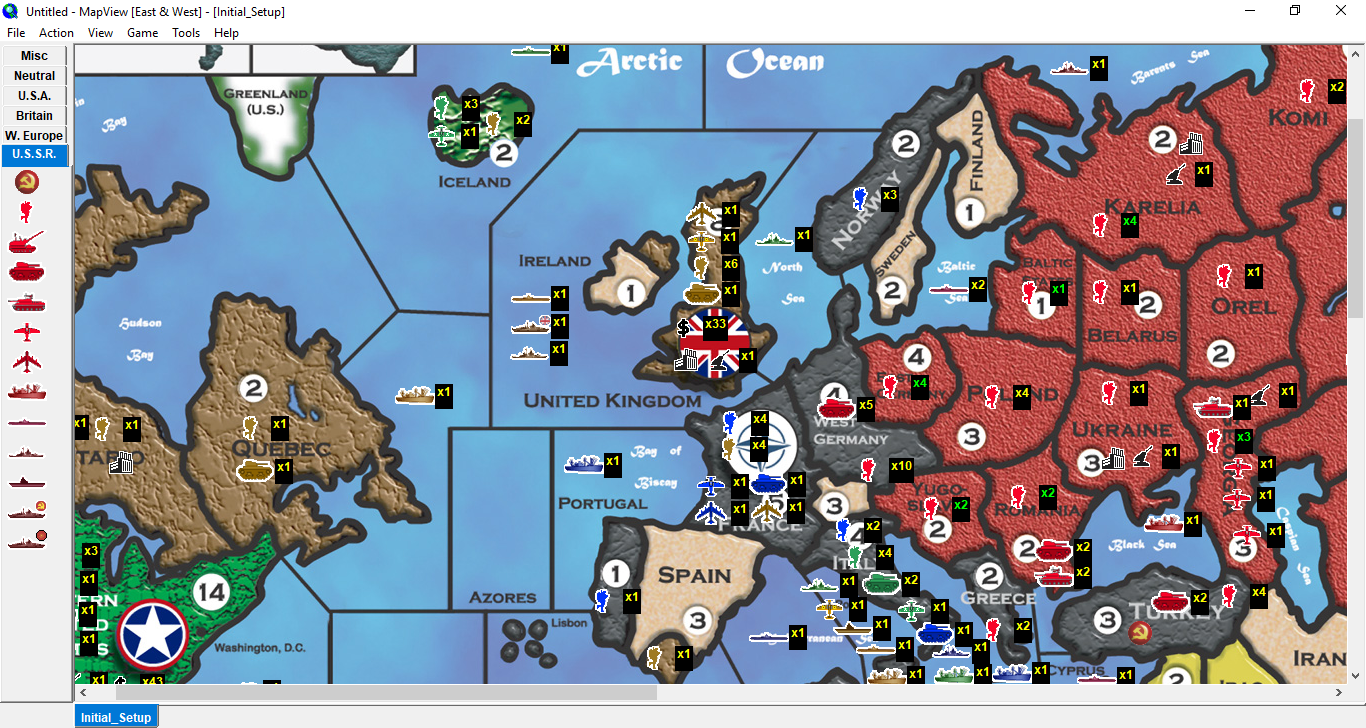Strategy: Operation Underbelly (Soviet focus on India)
This will likely be a multi-post topic, since there are so many moving parts.
Objectives:
- Reposition naval, air, and armored forces (on round 1) to strike at India on subsequent rounds
- Secure front-line, back-line, and coastal positions
There are obviously other considerations (which I will go into at more depth as they become pertinent) but those are the broad ideas behind this strategy.
“Round Zero”
With the standard “bid” of 20 IPCs, going with 10 infantry is usually the default action. Now, normally you would put these infantry into position to be used in combat immediately on round 1; this, however, is not entirely the case with this strategy. Since the USSR starts with so few forces in central Asia, we need to leverage round 0 to offset this, if we want to have any chance of overpowering the placement/reinforcement capability of the UK in India.
I suggest this placement:
1 inf - Mongolia
2 inf - Kazakhstan
2 inf - Turkmenistan
3 inf - Georgia
2 inf - Romania
The infantry in Mongolia, Kazakhstan, and Turkmenistan can all reach the friendly Chinese territory of Sinkiang, which shares a border with India. We want the extra infantry in Georgia to help ensure we take Turkey on round 1 – granting us control of the strait, and thus defending our “back-line” territories (in this case, Romania, Ukraine, and Georgia.) We also want to be able to take out Greece; this destroys some valuable NATO equipment, as well as denying them a free place to land reinforcements. Ultimately, we want to spend as little time as possible dithering in the Balkans, so that we can get on to the rest of Europe.
Round 1: Combat Movement
(I’ve run all of these combats through the helpful calculator, provided at http://calc.axisandallies.org/ but feel free to test them for yourself) :)
Since the subsequent non-combat moves are pivotal to the overall strategy, I’m going to make note of how much movement the offensive units need to use, to get into combat.
West Germany: (1 bmb, 8 inf, 4 arm, 2 ftr)
East Germany: 10 inf, 2 arm, 1 hrm, 1 ftr (moved 1 space)
Poland: 6 inf, 1 arm, 1 ftr (moved 1 space)
Yugoslavia: 4 inf, 1 arm (moved 1 space)
Baltic States: 1 arm (moved 2 spaces)
Total offense: 20 inf, 5 arm, 1 hrm, 2 ftr
Greece: (4 inf, 1 arm, 1 ftr)
Poland: 1 hrm (moved 2 spaces)
Yugoslavia: 1 ftr (moved 1 space)
Romania: 6 inf, 2 arm (moved 1 space)
Total offense: 6 inf, 2 arm, 1 hrm, 1 ftr
Turkey: (6 inf, 1 arm, 1 ftr)
Ukraine: 2 inf (amphibious) via Black Sea transport
Ukraine: 1 ftr (moved 2 spaces)
Georgia: 7 inf
Russia (aka Moscow): 2 arm, 1 hrm (moved 2 spaces)
Total offense: 9 inf, 2 arm, 1 hrm, 1 ftr
Pakistan: (1 inf)
Russia: 1 ftr (moved 3 spaces)
Turkmenistan: 3 inf
Total offense: 3 inf, 1 ftr
India SZ: (1 sub, 1 trn)
Russia: 1 bmb (moved 4 spaces)
Total offense: 1 bmb
Japan SZ: (1 sub, 1 crz, 1 BB)
East Siberia: 2 trn, 2 sub
Kamchatka: 1 ftr (moved 2 spaces)
North Korea: 1 ftr (moved 1 space)
Total offense: 2 trn, 2 sub, 2 ftr
North Sea: (2 trn, 1 crz)
Komi SZ: 1 trn, 2 sub, 1 crz
Baltic SZ: 1 sub
Total offense: 1 trn, 3 sub, 1 crz
Theorycraft: The Thinking Behind it All
- Yugoslavia armor to West Germany/Poland heavy armor to Greece.
As I mentioned earlier, we don’t want to leave units stranded in the Balkans for very long, if we can help it. This is why the armor is sent to West Germany rather than Greece, while the heavy armor (with its extra movement) is sent to Greece rather than West Germany.
- Fighters in West Germany/Greece
These aircraft are only moved 1 space, allowing them 3 spaces of movement on non-combat, for maximum flexibility in their redeployment.
- Why Pakistan?
Part of the problem with India, is the number of places which it can draw forces from; taking out Pakistan removes one such place. It also grants you a potential landing space, for aircraft to be used against the Persian Gulf (i.e. Pakistan SZ) on following rounds.
- Disrupting the convoy routes
In order to keep India from getting resupply, it is important to send our bomber against the India SZ. There are a couple ways to come at this: you want to at least strafe, and destroy the sub, so that it cannot be used to block or attack your naval units; if you also destroy the transport, this prevents the UK from moving an infantry immediately in from Singapore, or from sending it down towards South Africa (as part of a shuck-shuck strategy into Pakistan, on subsequent rounds.) It’s important to position your units to hit the sea zones near India early, since it will take until at least round 2 for UK surface ships to arrive.
- Japan SZ: The “cut and thrust”
While the US transports in the area make for a tactically sound alternative target, the reason to take out the Japan SZ fleet, is to prevent it from being able to move towards the Burma SZ, providing cover (and an early rallying point) for UK transports in the area. As said before, we want these transports to be exposed to our air power for as long as we can manage. The reason why our cruisers are left out of this attack, is twofold: generally when the Soviet Pacific fleet masses in one zone, it gets taken out by the nuke, and; we want to be able to non-combat move these ships to the Shanghai SZ, putting them within 2 spaces of the India SZ. This puts us out of the various deadzones in the Pacific, and well out of range of US aircraft.
We also want to use our submarines in the attack, since their “first strike” ability makes them the stronger offensive unit, while the cruisers are clearly the better defensive option. The Shanghai SZ is only within range of the US fighter in South Korea, and the US sub at Guam. However, if the US chooses to retreat their sub from our attack, this can cause many problems. First, it can block the Shanghai SZ; this means our cruisers will have to instead move to the Philippines SZ (if we still want them to be able to reach the India SZ) putting them within range of the US fighter in the Hawaiian SZ, as well as the bomber from Western US (potentially. ) Secondly, this would leave the US with another sub that they can use as fodder in any counter-attack. If the US does manage to put the Soviet fleet in a position to be counter-attacked strongly, we at least want to put forward our best defensive option; if the US can only commit 1 sub to this action, we might be able to take out one of their planes, potentially weakening any defensive boost they could provide to India, in the early rounds.
An alternate move would be to use our cruisers in the “cut” against Japan SZ, and our transports for the “thrust” into Shanghai SZ. This would allow infantry to be transported to Hunan, where they can directly threaten Indochina on round 2 – but there are a few problems with this move. As mentioned, if the US chooses to save their sub, this would completely block the Soviets from making a safe landing of their infantry. The other problem is that (particularly after round 1) NATO is not going to be generating many reinforcements out of Indochina, meaning it is not a high priority target. In order to successfully take the territory, the Soviets would likely have to divert offensive units away from India. And finally, as a place for the Soviets to generate additional infantry (to support attacks into India) … well, Indochina (as it turns out) would be too little, too late. The infantry which would be used for this landing are simply better off being walked down to their target (as I will get into further, during the non-combat discussion.)
It’s my estimation that NATO’s best move is always to just reinforce India as heavily as possible (and abandon Indochina straight away, rather than try and split their defensive forces) so that’s the strategy I’m planning against, as the Soviets. If NATO does beef up Indochina, you’re not going to have enough infantry to take it, and if they abandon it, you’re not going to have enough offense to take it – because you’ll have to commit more of those to India, to match NATO’s defensive commitment there. India has to be the first priority.
- The North Sea
In a strategy that was not so strongly focused on India, I feel like it would be wise to commit more air power towards this theatre. As it is, your navies can generally only be relied on to survive a round or two (at the best of times) so you won’t have much of an opportunity to stir the pot with these ships. Taking out the transports causes the US to have to spend money replacing them, and the North Sea also happens to be the obvious rendezvous point for your two different groups of ships in the area. I think the strategy here should be to strafe, and then retreat your subs back behind the strait, while retreating any surface ships back to Komi SZ. Again, keeping your navies sort of spread out makes them a less desirable target for the nuke, but (particularly in this theatre) also forces NATO to spread their air power out, and away from places that they probably want to be redeploying them on non-combat.
(to be continued)













